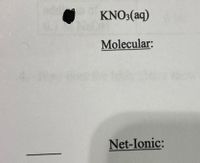
Chemistry
10th Edition
ISBN: 9781305957404
Author: Steven S. Zumdahl, Susan A. Zumdahl, Donald J. DeCoste
Publisher: Cengage Learning
expand_more
expand_more
format_list_bulleted
Concept explainers
Question
Hello, can you please solve this question and please show all your work. Thank you. Please figure out the molecular and net-ionic equations. Also, is it acidic neutral, or basic?

Transcribed Image Text:KNO3(aq)
Molecular:
Net-Ionic:
Expert Solution
This question has been solved!
Explore an expertly crafted, step-by-step solution for a thorough understanding of key concepts.
Step by stepSolved in 2 steps with 1 images

Knowledge Booster
Learn more about
Need a deep-dive on the concept behind this application? Look no further. Learn more about this topic, chemistry and related others by exploring similar questions and additional content below.Similar questions
- You wish to make a 0.315 M perchloric acid solution from a stock solution of 12.0 M perchloric acid. How much concentrated acid must you add to obtain a total volume of 100 mL of the dilute solution? mL Submit Answer Retry Entire Group 9 more group attempts remainingarrow_forwardUse the References to access important values if needed for this question. Write the net ionic equation for the acid-base equilibrium that is established when ammonium chloride is dissolved in water. (Use H30* for hydronium ion. Use the lowest possible coefficients. Be sure to specify states such as (aq) or (s). If a box is not needed, leave it blank.) + H₂O(l) This solution is Submit Answer ? Retry Entire Group + 9 more group attempts remainingarrow_forwardThe different between strong and weak acids and bases is that ... strong acids or bases are solutions of low concentration. only some molecules of a strong acid or base react with water. all of the molecules of a strong acid or base react with water. Selected strong acids or bases are solutions of high concentration. 2 UNANSWERED QUESTION 3/5 CONTINUE 4:16 / 13:48 1x Xarrow_forward
- Please don't provide handwritten solution ....arrow_forwardGet two medium test tubes. Into one, place about 2 mL of a solution of hydrochloric acid. Into the other add a small amount of solid sodium carbonate. Note the appearances of the contents in the two test tubes and then mix them together noting any changes that have taken place. what changes take place? whats the balanced equation? whats the ionic? whats the net ionicarrow_forwardThe answer for Sodium Phosphate is 15 mMol. I'm not sure how they got this answer?arrow_forward
- Please answer the questionarrow_forwardPlease provide steps so I understand how to do pleasearrow_forwardSIMPLE REACTIONS Shamma V Determining the volume of base neede... A chem student weighs out 0.0999 g of acetic acid (HCH,CO,) into a 250. mL volumetric flask and dilutes to the mark with distilled water. He plans to titrate the acid with 0.1100 M NAOH solution. Calculate the volume of NaOH solution the student will need to add to reach the equivalence point. Round your answer to 3 significant digits. ||mL O ml. x10 dlo 18 Ar Explanation Check O 2021 Mcolaw- LUutatioI. All RightS RESEIVEU. Privacy Accessibilityarrow_forward
- urces UIW Web Library Online Tips UIW Course Policies, Guidelines and Accommodations try 02 Fa 20 CHEM1310 02_Fa_20 Module 11 11. Reactions of Acids and Bases ... Identify types of reactions involving acids and bases Question Complete and balance the chemical equation for the neutralization reaction of phosphoric acid (H, PO,(aq)) and sodium hydroxide (NAOH(aq)). 4. • Write the chemical equation in molecular form (do not show dissociated ions). • Include the state (phase) of each chemical species. Provide your answer below: H,PO,(aq) +NaOH(aq) →D FEEDBACK MORE INSTRUCTION SUBMIT Content attribution >arrow_forwardThey are really hard I cant understand ?? Plz someone help me??arrow_forwardPlease help with A B and Carrow_forward
arrow_back_ios
SEE MORE QUESTIONS
arrow_forward_ios
Recommended textbooks for you
 ChemistryChemistryISBN:9781305957404Author:Steven S. Zumdahl, Susan A. Zumdahl, Donald J. DeCostePublisher:Cengage Learning
ChemistryChemistryISBN:9781305957404Author:Steven S. Zumdahl, Susan A. Zumdahl, Donald J. DeCostePublisher:Cengage Learning ChemistryChemistryISBN:9781259911156Author:Raymond Chang Dr., Jason Overby ProfessorPublisher:McGraw-Hill Education
ChemistryChemistryISBN:9781259911156Author:Raymond Chang Dr., Jason Overby ProfessorPublisher:McGraw-Hill Education Principles of Instrumental AnalysisChemistryISBN:9781305577213Author:Douglas A. Skoog, F. James Holler, Stanley R. CrouchPublisher:Cengage Learning
Principles of Instrumental AnalysisChemistryISBN:9781305577213Author:Douglas A. Skoog, F. James Holler, Stanley R. CrouchPublisher:Cengage Learning Organic ChemistryChemistryISBN:9780078021558Author:Janice Gorzynski Smith Dr.Publisher:McGraw-Hill Education
Organic ChemistryChemistryISBN:9780078021558Author:Janice Gorzynski Smith Dr.Publisher:McGraw-Hill Education Chemistry: Principles and ReactionsChemistryISBN:9781305079373Author:William L. Masterton, Cecile N. HurleyPublisher:Cengage Learning
Chemistry: Principles and ReactionsChemistryISBN:9781305079373Author:William L. Masterton, Cecile N. HurleyPublisher:Cengage Learning Elementary Principles of Chemical Processes, Bind...ChemistryISBN:9781118431221Author:Richard M. Felder, Ronald W. Rousseau, Lisa G. BullardPublisher:WILEY
Elementary Principles of Chemical Processes, Bind...ChemistryISBN:9781118431221Author:Richard M. Felder, Ronald W. Rousseau, Lisa G. BullardPublisher:WILEY

Chemistry
Chemistry
ISBN:9781305957404
Author:Steven S. Zumdahl, Susan A. Zumdahl, Donald J. DeCoste
Publisher:Cengage Learning

Chemistry
Chemistry
ISBN:9781259911156
Author:Raymond Chang Dr., Jason Overby Professor
Publisher:McGraw-Hill Education

Principles of Instrumental Analysis
Chemistry
ISBN:9781305577213
Author:Douglas A. Skoog, F. James Holler, Stanley R. Crouch
Publisher:Cengage Learning

Organic Chemistry
Chemistry
ISBN:9780078021558
Author:Janice Gorzynski Smith Dr.
Publisher:McGraw-Hill Education

Chemistry: Principles and Reactions
Chemistry
ISBN:9781305079373
Author:William L. Masterton, Cecile N. Hurley
Publisher:Cengage Learning

Elementary Principles of Chemical Processes, Bind...
Chemistry
ISBN:9781118431221
Author:Richard M. Felder, Ronald W. Rousseau, Lisa G. Bullard
Publisher:WILEY